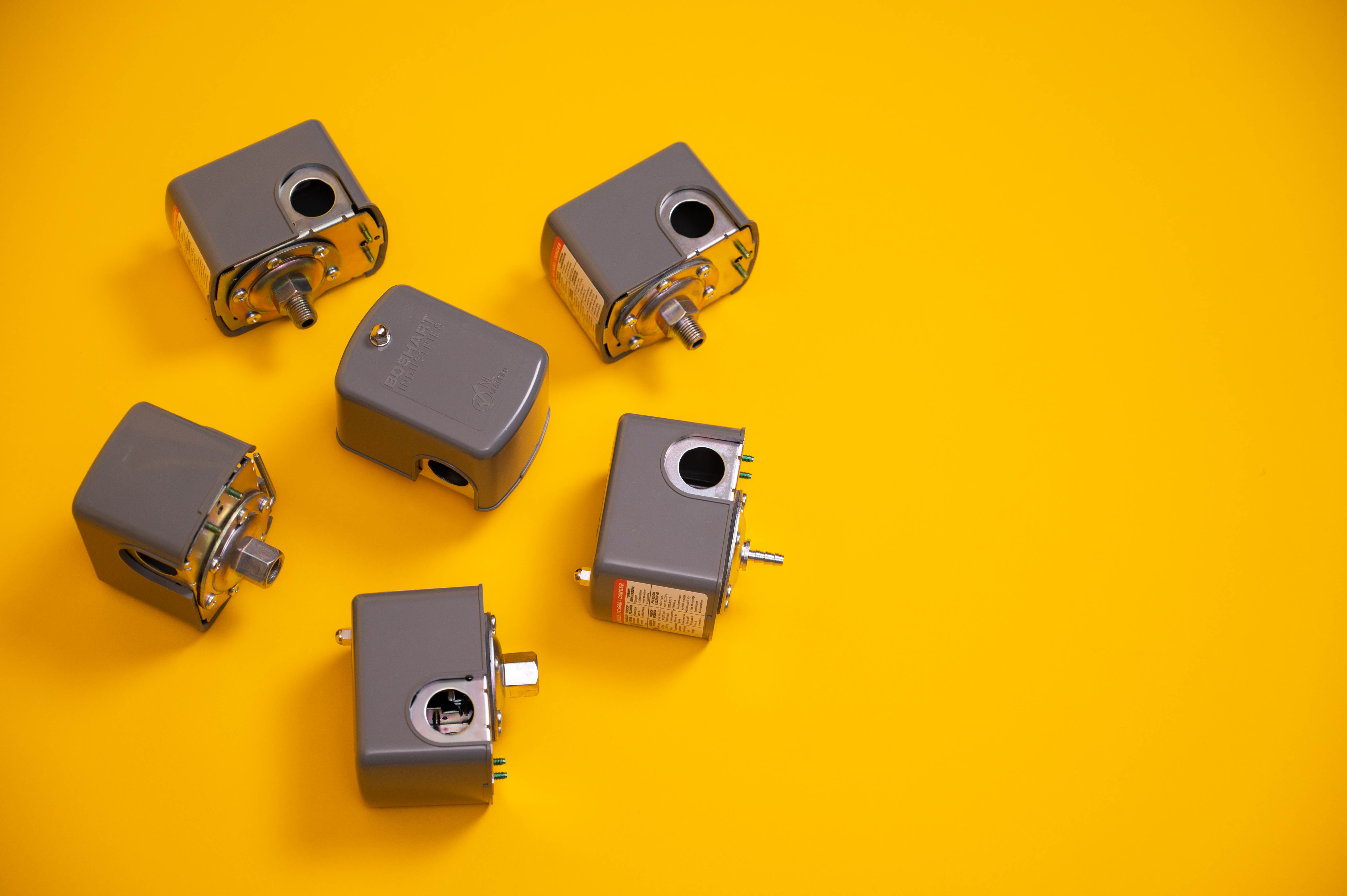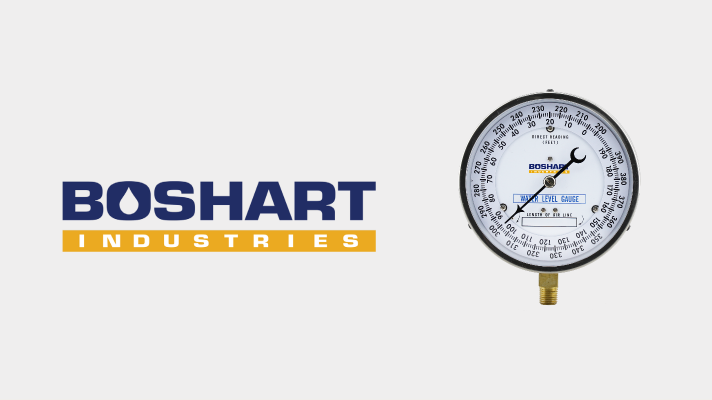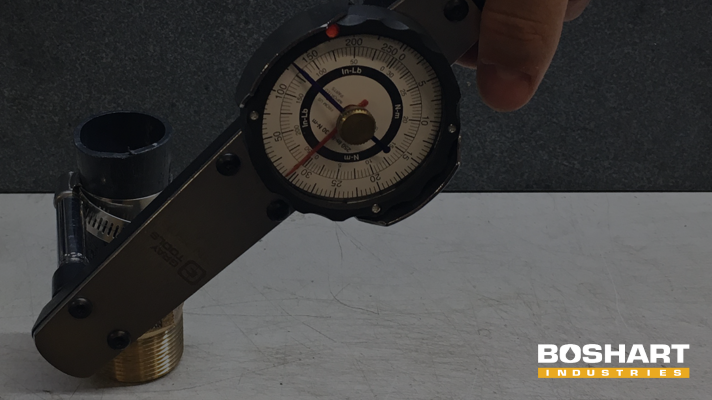In this webinar, we first discuss what a pressure gauge is. Then, we take a look at some things you should know when selecting a gauge, as well as the different types of special application pressure gauges available. After that, we look at some benefits of Boshart gauges, as well as some installation tips and accessories. We then end the webinar with questions. Check it out below.
Transcript
Hello everyone. Welcome to our webinar on pressure gauges and thank you for joining us today.
My name is Melissa Bender and I’m the Social Media and Content Coordinator here at Boshart Industries. Today, I’m joined by Will Bender, our Quality Assurance Analyst, Steve Hudson, our Quality Assurance Manager and Paul Erb, our Research and Development Manager. They will help answer your questions at the end of the webinar.
Overview
To start, we will discuss what a pressure gauge is. Next, we will take a look at some things you should know when selecting a gauge, as well as the different types of special application pressure gauges available. Then, we will look at some benefits of Boshart gauges, as well as some installation tips and accessories. We will then end the webinar with questions.
What is a Pressure Gauge?
Simply put, a pressure gauge measures the internal pressure of a system. Boshart offers pressure gauges in a variety of styles and sizes to meet the demands of standard and special applications. General purpose pressure gauges can be used anywhere where pressure needs to be measured.
With the exception of low pressure gauges, all of Boshart’s pressure gauges are constructed with a bourdon tube sensing element. When the sensing element is subjected to pressure, it flexes. When the bourdon tube flexes, it moves the internal components, which in turn, moves the pointer along the dial face.
Our bourdon pressure gauges can be used in residential water pressure systems, refineries, hydraulic installations, pneumatic installations, exploration wells, petrochemical plants, power stations and wastewater operations.
8 Things you Need to Know When Selecting a Pressure Gauge
When selecting a pressure gauge for a potable water application, the gauge must be NO-LEAD certified to the NSF-372 standard as required by the Safe Drinking Water Act. No-lead gauges can be used for all water types, while non-potable water gauges can only be used for non-potable applications.
All of our stainless steel gauges are ideal for both potable and non-potable water applications where superior corrosion resistance is desired and chemical compatibility issues are a factor.
When selecting a gauge for a chemical application, please contact us and we will verify with the manufacturer that your chemical is compatible. We will require some information on the application such as the chemical used, the concentration of that chemical, and the pressure and temperature of the system.
Pressure range selection is critical. Typically, a gauge should have twice the range as the system’s operating pressure. This ensures that the operating pressure is within the most accurate section of the gauge. In general, the operating pressure should never exceed 75% of the gauge range. If the operating pressure exceeds 75%, the bourdon tube will lose its elasticity and the gauge will lose its accuracy. When pressure pulsations are expected, the operating pressure should not exceed two thirds of the gauge range.
Ideally, the pointer should be in the 12:00 position at mid-range of the system operating pressure. This animation shows normal, ideal operating conditions. When the needle is pointing vertically, the system is operating within range. When the pointer is way below or way above this 12:00 position, the system may need attention.
1½", 2", 2½" and 4" dial faces are the most commonly used sizes. Cases are available in plastic, steel and stainless steel materials. All liquid filled gauges are manufactured with sealed cases. Some dry gauges are also manufactured with sealed cases as well.
Dry Gauges
Dry gauges are best used in environments where mechanical vibrations are not a concern, while liquid filled gauges are best used for measuring pressure points of high stress like fast and frequent loads, pressure peaks and mechanical vibration. In other words, if the system is expected to change pressure rapidly or frequently, a liquid-filled gauge is best.
Liquid Gauges
Liquid-filled pressure gauges provide a number of advantages. This animation shows how the thick consistency of the liquid absorbs vibration and pressure spikes. During conditions of rapid dynamic loading and vibration, this dampening action of the liquid provides easy readability.
Boshart’s gauges are filled with 99.9% glycerine. Glycerine is non-toxic, biodegradable and not hazardous to water. When lowered to +17°C, glycerine starts to become viscous. As the temperature further decreases, the glycerine becomes even more viscous and causes the pointer to move more slowly to the correct position. At -5°C, these gauges are no longer able to operate.
For operating temperatures less than -5°C, glycerine should be mixed with water. A ratio of two parts glycerine and one part water lowers the freezing point from -5°C to -46°C. This two thirds glycerine mix can now be used in colder temperatures.
In addition, glycerine lubricates the internal components, and in turn, dramatically reduces wear on the internal components of the gauge and increases the lifespan of the gauge. Since glycerine is a non-aqueous liquid, it performs well in both corrosive and colder environments.
Pressure Gauge Mounts
Lower mount and center back mount connections with national pipe thread are the most popular types for pressure systems in the U.S. and Canada. The difference between a lower mount and a center back mount is simply the direction the gauge dial faces in relation to the pressure connection.
Boshart’s gauges have an accuracy rating that ranges from +-3-2-3% up to an accuracy rating of 1% full scale.
The accuracy of the 1% full scale means that at any given pressure, the accuracy of the pointer on the gauge face is + or – 1%.
To understand the accuracy rating of +-3-2-3%, you need to divide the values on the gauge face into three parts. From 0% to 25% of the gauge, the accuracy of the pointer will be + or – 3%. From 25% to 75% of the gauge, the accuracy of the pointer is + or - 2%. From 75% to 100% of the gauge, the accuracy of the pointer is + or – 3%.
Gauge accuracy requirements are covered under the ASME B40.100 standard.
In summary, if pressure accuracy is critical, you will want to choose a gauge that has a higher accuracy rating.
All of Boshart’s gauges are rated for a maximum media temperature of 140º F and an ambient temperature range of -40°F to 140°F. Although they are rated to -40°F, the gauge must not be subjected to temperatures that will freeze the liquid inside the pressure gauge. Freezing will cause the media to expand, and in turn, will cause damage to the gauge, as well as possible water damage when the gauge thaws out.
Please note that ambient temperatures may affect the accuracy of the gauge. Therefore, the gauge should be isolated from temperature extremes.
Special Application Pressure Gauges Available
Low pressure gauges are commonly used in chemical, petrochemical, plant construction and pneumatic systems. Unlike other gauges, low pressure gauges have a copper alloy capsule type element and are printed with a dual scale. The outer black scale is in inches of water and the inner red scale is in mm of water.
The capsule on the pressure gauge consists of two circular metallic disks which mechanically deform as the pressure changes. Diaphragms are connected to each other and are tightly sealed around the edges with solder. The pressure is exerted on the inside of the capsule and are very sensitive to small changes in pressure.
Extreme caution must be taken to ensure that these gauges are not over pressurized. The slightest pressure spike will damage the internal components of the gauge, ruin its accuracy and make it unusable.
Boshart’s 4 ½” dial gauges, also know as contractor gauges, are commonly used in air conditioning, heating, plumbing and refrigeration. This rugged and reliable gauge is economically priced and offers many features normally found on more expensive gauges. Contractor gauges are the most accurate gauge that we carry with an accuracy rating of 1% full scale. The large dial face also offers easy readability.
Vacuum gauges measure pressures lower than the ambient atmospheric pressure, while combination gauges measure both pressures lower and higher than ambient atmospheric pressures. The ambient atmospheric pressure is set at 0 on a gauge.
Water test gauges provide a quick and easy way to test a system for leaks. With a standard ¾" garden hose connection and washer, this gauge easily attaches to hose bibbs, boiler drains and lawn faucets. These gauges are also often used with our flexible end caps which cover pipe ends during testing or clean outs in drainage, waste and ventilation systems. Water test gauges are also often used to measure commercial and residential water pressure.
Models with "MP" in the part number indicates that the gauge is equipped with a maximum pressure pointer, also known as a drag pointer or high point indicator. This maximum pressure pointer allows you to monitor a peak operating or surge pressure point. With increasing pressure, the red pointer follows the regular pointer and remains at the highest point until it is reset by a knob on the front of the window.
Gas test gauges provide a quick and easy way to pressurize and monitor a gas system for leaks. These gauges come completely assembled on a brass hex manifold or a malleable concentric reducer coupling with side port that incorporates an air valve complete with plastic cap. Both are available with pressure ranges from 15 – 200 PSI. After installing a gas test gauge, the system is pressurized with air. Any leakage will be indicated by a pressure drop on the gauge.
Despite their name, these gauges can also be used in non-gas pressure test applications.
Water level gauges measure the distance from the top of the well to the water level. The gauge needs to be attached to an air compressor with an air line. The air line is fed down to the bottom of the well. The air compressor adds pressure to the air line until it pushes the water out of the air line. The gauge will read the distance of water that was pushed out of the air line. This is called the head of water. The head of water is subtracted from the length of the air line and that gives the operator the water level depth.
Please note that this process needs to be done each time the water level needs to be read.
Please reach out if you want more information on this complex type of gauge.
Benefits of Boshart Gauges
With Boshart gauges, there’s no need to worry about shattered glass if a gauge gets damaged. All of our gauges come with a durable acrylic or polycarbonate viewing window to eliminate this messy and dangerous risk.
All Boshart sealed case gauges have the MPT connection tapped to allow for the installation of a restrictor screw. While 0-600 PSI gauges are not supplied with a restrictor screw, gauges 600 PSI and above are supplied with a restrictor screw installed. If the restrictor screw is not needed, it can be removed.
The restrictor screw dampens the effects of pulsation, which in turn, helps prevent internal damage to the bourdon tube and extends the life of the gauge. Restrictor screws are installed in high pressure gauge ranges because at high system pressures, there is an increased risk of damage from pressure surges.
Boshart pays a premium to have our gauge pressure connections manufactured with plunge cut solder sockets. This design eliminates the risk of failure due to poor solder connections. The solder, which is retained in the pocket, will create a superior seal. The pocket also ensures that the bourdon tube is properly aligned with the internal components and increases life expectancy.
On the right-hand side of the slide, you will see a typical competitor’s gauge with a slot cut solder connection. While these connections are cheaper to manufacture, they are more likely to fail.
Boshart also pays a premium to have our gauges manufactured with solid one-piece pressure connections. This heavy-duty design eliminates the risk of the connection breaking when installing or replacing.
On the right-hand side of the slide, you will see a typical competitor’s gauge with a cored connection. This extremely thin wall can break when tightening the gauge and is especially prone to breaking when removing the gauge. Oftentimes, a plug is inserted into the cored connection to give the appearance of a solid connection. Corrosion can easily happen between the connection and the inserted plug.
Installation Tips
Instead of applying a torque to the gauge case, an open end or adjustable wrench should be used. It should be used on the wrench flats of the gauge socket to tighten the gauge into the fitting or pipe.
When removed from the carton, the gauge pointer may not be at 0. Before assembly, the gauge pointer must be set to 0. All mechanical liquid filled gauge cases are sealed to keep liquid in during shipping. As they heat up, pressure builds up in the case. For every 30-40°F temperature change, the pressure increases by 1 PSI.
To fix this problem, cut the tip off the nipple plug. When installing the gauge, ensure that the nipple plug is facing up so there is an air bubble below the plug. Then, cut the nipple off the plug to avoid the loss of liquid. This will equalize the case pressure and ensure an accurate reading regardless of gauge temperature.
If the gauge cannot be installed with the plug facing up, do not remove or cut the seal plug. Leave the gauge sealed to retain the liquid. To get an accurate reading, the gauge will need to be manually vented every time an accurate reading is required. To vent manually, simply push the side of the vent plug with your thumbnail to break the seal and equalize the gauge case pressure. A small amount of liquid will escape with each venting. A small loss of liquid will not affect operation of the gauge. Simply wipe any liquid that escaped with a cloth. If you find you have to frequently vent the gauge, you may need to refill the gauge.
Most often, this problem can be avoided by installing a center back mount connection gauge.
The majority of dry gauges do not need to be vented since they do not have a sealed case design or a sealing plug. However, all gauges, dry and liquid, with a sealed case will need to be vented.
For more information on venting, you can check out this blog post.
Pressure Gauge Accessories
If you don’t want the plumbing behind the gauge to be visible, there are two mounting bracket options available for sealed case gauges. The first is a front flange system. Here, the bracket is visible when installed.
The second is a concealed rear mount U-clamp system. Here, the mounting clamp is hidden behind the panel.
Pressure snubbers are installed ahead of pressure sensing instruments to protect them from rapid pulsations and damaging shocks. Pressure snubbers can increase the life expectancy of a pressure gauge.
Pigtail siphons protect the pressure gauge from hot pressure media, like steam, and reduce the effect of rapid pressure surges. The pressure medium forms a condensate and is collected inside the coil or pigtail portion of the siphon. The condensate prevents the hot media from coming in direct contact with the pressure gauge. These siphons are available in both steel and brass. When installing, these siphons should be filled with water or another suitable separating liquid.
Questions
What other accuracy ratings are there other than the +-3-2-3% and 1% full scale?
Other than the +-3-2-3% and 1% full scale, we have gauges that have a 1.5% full scale rating, like the 2.5-inch sealed case gauges, and a 2.5% full scale rating, like 4-inch dry gauges.
Your catalog says that your gauges are not for use with oxygen. Why?
Our general purpose gauges should not be used with oxygen because they may have oil and grease residue from the manufacturing process. These are common hydrocarbons that can react violently and potentially result in explosions, fire, and injury to personnel and property. Special cleaning is required to remove all hydrocarbons for oxygen service. Our general purpose gauges, dry and liquid filled, must not be used on oxygen systems or other oxidizing media.
Why are your gauges rated at only 140°F when the internal components are made of brass and copper alloys which can withstand higher temperatures?
Our gauges are rated to 140°F because they have plastic lenses. For applications with higher temperatures, laminated safety glass should be used because it reduces the possibility of shattering if the bourdon tube ruptures.
Thanks everyone for submitting your questions. We will move on now but if we didn’t get to your question, we will reach out to you shortly.
Conclusion
We’ve reached the end of the webinar. Visit our BoshartU blog to learn more about our products and be sure to subscribe.
Stay connected with us by following Boshart Industries on Instagram, LinkedIn, and Facebook.
Thank you again for joining us today. Check out our website to learn more and enjoy the rest of your day.
Have further questions about this subject?

Head over to Boshart's Knowledge Base: technical product information, guidelines, and more.





SHARE